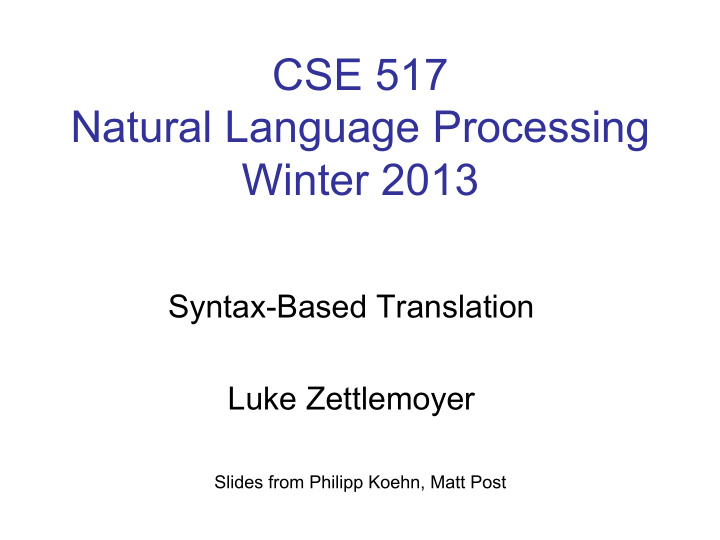



CSE 517 Natural Language Processing Winter 2013 Syntax-Based Translation Luke Zettlemoyer Slides from Philipp Koehn, Matt Post
Levels of Transfer
Goals of Translating with Syntax § Reordering driven by syntactic § E.g., move German verb to final position § Better explanation for function words § E.g., prepositions and determiners § Allow long distance dependencies § Translation of verb may depend on subject or object, which can have high string distance § Will allow for the use of syntactic language models
Syntactic Language Models § Allows for long distance dependencies • S ? NP S VP VP NP PP NP VP the house of the man is small the house is the man is small § Left translation would be preferred!
String to Tree Translation interlingua foreign english semantics semantics foreign english syntax syntax foreign english words words § Create English syntax trees during translation [Yamada and Knight, 2001] § very early attempt to learn syntactic translation models § use state-of-the-art parsers for training § allows us to model translation as a parsing problem, reusing algorithms, etc.
Yamada and Knight [2001] § p(f|e) is a generative process from an English tree to a foreign string VB VB PRP VB2 VB1 reorder PRP VB1 VB2 reorder he TO VB adores he adores VB TO MN TO listening listening TO MN music music to to music VB VB insert insert PRP VB2 VB1 PRP VB2 VB1 desu kare ha TO VB ga daisuki desu he ha TO VB ga adores desu translate MN TO kiku no MN TO listening no ongaku wo translate ongaku wo take leaves music to take leaves Kare ha ongaku wo kiku no ga daisuki desu
Learned Model § Reordering Table Original Order Reordering p(reorder | original) PRP VB1 VB2 PRP VB1 VB2 0.074 PRP VB1 VB2 PRP VB2 VB1 0.723 PRP VB1 VB2 VB1 PRP VB2 0.061 PRP VB1 VB2 VB1 VB2 PRP 0.037 PRP VB1 VB2 VB2 PRP VB1 0.083 PRP VB1 VB2 VB2 VB1 PRP 0.021 VB TO VB TO 0.107 VB TO TO VB 0.893 TO NN TO NN 0.251 TO NN NN TO 0.749
Yamada and Knight: Decoding § A Parsing Problem § Can use CKY Algorithm, with rules that encode reordering, inserted works VB VB2 PP PRP NN TO VB VB1 he music to listening adores kare ha ongaku wo kiku no ga daisuki desu
Yamada and Knight: Decoding § A Parsing Problem § Can use CKY Algorithm, with rules that encode reordering, inserted works VB VB2 PP PRP NN TO VB VB1 he music to listening adores kare ha ongaku wo kiku no ga daisuki desu
Yamada and Knight: Training § Want P(f|e), where e is a English parse tree § Parse the English side of bi-text § Use parser output as gold standard § Many different derivations from e to f (for a fixed pair) § Use EM training approach § Same idea as IBM Models (but a bit more complex)
Is The Model Realistic? § Do English trees align well onto foreign string? § Crossings between French-English [Fox, 2002] § ~1-5 per sentence (depending on how you count) § Can be reduced by § Flattening tree, as done by Yamada and Knight § Mixing in phrase level translations § Special casing many constructions
What about tree-to-tree? § Consider the following trees: Mary did not slap the green witch Maria no daba una bofetada a la bruja verde inary tree § We might merge them as follows: Mary did not slap * * * the green witch Maria * no daba una bofetada a la verde bruja
Inversion Transduction Grammars (ITGs) § Simultaneously generates two trees (English and Foreign) [Wu, 1997] § Rules, binary and unary § X à X 1 X 2 || X 1 X 2 § X à X 1 X 2 || X 2 X 1 § X à e||f § X à e||* Mary did not slap * * * the green witch Maria * no daba una bofetada a la verde bruja § X à *||f § Builds a common binary tree § Limits the possible reorderings § Challenging to model complete phrases § But, can do decoding as parsing, just like before!
Hierarchical Phrase Model [Chiang, 2005] § Hybrid of ITGs and phrase based translation § Word rules § X à maison || house § Phrasal Rules § X à daba una bofetada || slap § Mixed Terminal / Non-terminal Rules § X à X bleue || blue X § X à ne X pas || not X § X à X 1 X 2 || X 2 of X 1 § Technical Rules § S à S X || S X § S à X || X
Hierarchical Rule Extraction § Include all word and phrase alignments bofetada ıa verde § X à verde || green bruja Mar´ daba una no § X à bruja verde || green witch la a § … Mary § Consider every possible did rule, with variable for not slap subphrases the § X à X verde || green X green § X à bruja X || X witch witch § X à a la X || the X § X à daba una botefada || slap X § …
The Rest of The Details § See paper [Chiang, 2005] § Model is done much like phrase-based systems § Too many rules à Need to prune § Efficient parsing algorithms for decoding § How well does it work? § Chinese-English: 26.8 à 28.8 BLEU § Competitive with phrase-based systems on most other language pairs, but lags behind when the language pair has modest reordering § There has been significant work on better ways of extracting translation rules, and estimating parameters
Recommend
More recommend